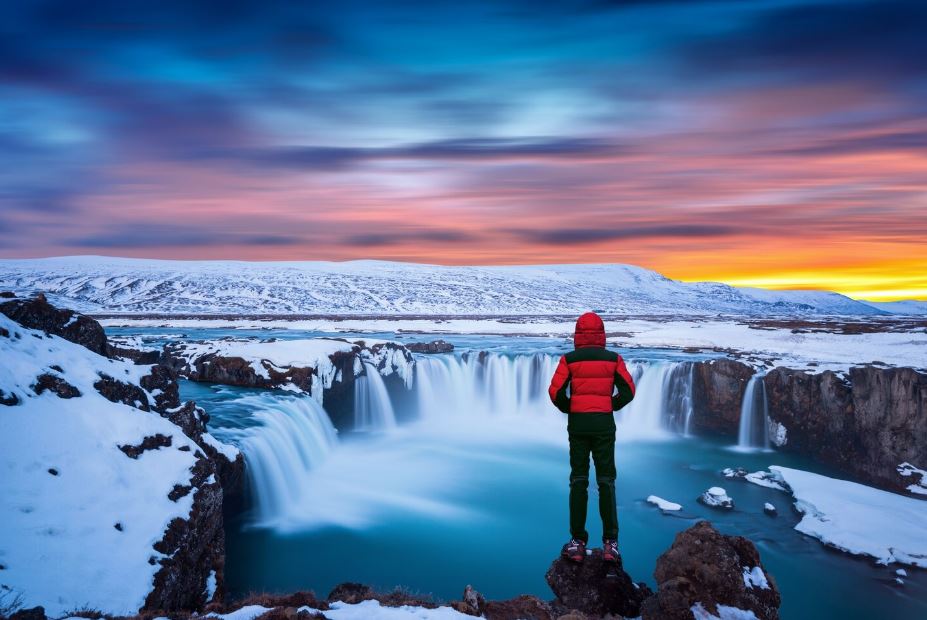
Iceland’s midnight sun is more than just a sight to behold; it seems as though nature is working in tandem with human ingenuity. It appears to photographers that a perpetual golden hour has been painted on the horizon. Painters can pursue detail without keeping an eye on the clock because it is a live canvas that changes subtly but never dims.
This phenomenon peaks in late June, when evening and morning blend together without giving in to darkness, and lasts from mid-May to early August. The sun can remain in the sky for a full day on Grímsey Island, casting a deliberately theatrical glow over the cliffs and ocean. The sky maintains a gentle pastel wash, akin to watercolors stretched across an endless canvas, even in Reykjavík, where the sun dips momentarily.
Key Facts About Iceland’s Midnight Sun
| Detail | Information |
|---|---|
| Location | Iceland, most vivid in northern areas like Grímsey Island |
| Phenomenon | Sun stays visible for nearly 24 hours during peak summer |
| Peak Season | Mid-June to early July, especially around June 21–22 |
| Daylight Duration | Up to 24 hours in the far north, 20–22 hours in Reykjavík |
| Cause | Earth’s axial tilt extending sunlight at high latitudes |
| Best For | Photography, painting, filmmaking, outdoor art |
| Famous Artistic Links | Inspired work of photographers like Iurie Belegurschi |
| Cultural Events | Jónsmessa, Secret Solstice Festival |
| Notable Viewing Spots | Grímsey Island, Westfjords, South Coast, Highlands |
The light’s gentleness and vibrancy, which saturate colors without harsh contrast, make it incredibly effective for artistic endeavors. Photographers frequently refer to it as a “living filter” because it adds color to volcanic sands, glaciers, and moss. Painters talk about how they can capture gradients that are impossible to replicate with artificial lighting.
The absence of time constraints is one advantage of this prolonged light. Artists are free to hone a shot or a stroke at their own speed without the constant threat of sunset. It is possible for a fashion photographer to take a midnight photo by a waterfall and still have steady lighting at two in the morning. While the light patiently holds, a plein-air painter can stay in front of a fjord and layer pigments.
There is a noticeable increase in the cultural energy during this time of year. Occasions such as the Secret Solstice Festival continue well into the “night,” with their stages illuminating against unyielding skies. Folklore is infused into traditional celebrations like Jónsmessa, where stories of magical creatures and healing dew are shared. This blend of cultural heritage and natural beauty is a particularly clear source of inspiration for a creative mind.
The variety of landscapes that Iceland’s midnight sun illuminates within such close proximity sets it apart from similar northern phenomena. Without changing your lighting setup, you could paint the layered slopes of rhyolite mountains, photograph black sand beaches, and capture the glimmer of a glacier lagoon in a single day. This amazing adaptability is one of the things that attracts artists from all over the world.
The country’s artistic rhythm is also shaped by the transition from the long darkness of winter to the endless day of summer. Reflective works are often the result of creativity turning inward during the winter months. The energy picks up speed in the summer, when immersive art experiences, group photo shoots, and outdoor installations flourish. Iceland’s creative culture is strengthened by this seasonal contrast, which serves as a reminder to artists to change and grow.
In this light, nature is at its best. Glaciers shimmer in gentle amber tones, puffins return to their nests, and lupine fields spread like violet seas. While painters may choose to focus on a single perspective and observe the subtle variations in tone hour after hour, photographers seek out these sights throughout the nation.
In these weeks, time itself seems to bend. Hours are hazy in the absence of true night. Some artists don’t stop until they’re exhausted, working through what would be midnight. When creativity takes control of the schedule instead of the clock, this distortion can be liberating. It is an uncommon type of productivity that is enabled by an abundance of light rather than its lack.
Under these skies, teamwork also thrives. Music videos capitalize on the steady glow, art workshops gather in open fields, and photography tours operate through the “night.” Crews and creatives can concentrate on their work instead of racing the sun thanks to these circumstances, which greatly lessen logistical stress.
Collective awe, however, is arguably the most noticeable result. Relationships are formed fast when strangers stand on a cliff overlooking the ocean at one in the morning and watch the sun peek over the horizon. The shared experience dissolves barriers. The midnight sun demands genuine, present engagement in a time when screens are attracting so much attention.
August brings the return of night. The magic wanes, and darkness once more takes control of the skies. But for those who have labored in that never-ending light, the memory endures—a reminder that nature and human ambition don’t always coincide. That alignment seems natural in Iceland, where the midnight sun rules the day.

